
Presentation is very important.
NOODLES
Noodles are to Japan what hamburgers are to America and pork pies and pasties are to England. (And of course, what pasta is to Italy). Available everywhere and very popular for lunch with busy workers, the Japanese can eat them icy cold with a dipping sauce as well as hot with an assortment of vegetables, meats, fish and eggs. Noodles must be eaten quickly before the hot broth makes them too soft. This entails a good deal of noisy slurping - perfectly acceptable to the Japanese - and the best evidence of enjoyment ! Two main types of noodle are available. Soba is made from buckwheat flour and is slightly brown in colour. Udon is a thick white type of noodle and is made from white flour.

Soba noodle..a complete meal
SASHIMI
Sashimi, also raw fish, comes in the form of thin slices and is eaten with a dip of horseradish-flavoured soy sauce.

Dip it with a mixture of soy sauce and wasabi...ichiban!!
SUSHI
The Japanese have never been great meat eaters until the turn of this century. A typical meal would probably consist of rice with vegetables or fish. Red meat is now consumed more readily but in those days fish and soya beans were perhaps the only form of protein consumed. Fish still predominates in the Japanese diet nowadays, however. Most people will have probably heard of sushi. This is not for the light-hearted as this dish consists of raw fish which has been laid onto vinegered rice which has been pressed into bite-sized cakes. The range of sushi available is large as it comes in all different shapes and sizes and toppings. Sushi bars or take-aways are abundant in Japan where it is served with liberal amounts of beer or sake. Those which cater for tourists often have plastic replicas of the different types of sushi from which you can make your choice.
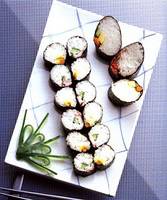
It's everywhere nowadays even your local neighbourhood pasar malam
BENTO
Set-meals are plentiful in Japan and a Bento is such an example. They are packed lunches which come in the form of rectangular boxes with compartments for different foods. They are always prettily arranged and come in all sizes and shapes - heart shapes, tennis racket shapes, doll shapes to name just a few. So what's in a Bento ? There's rice, a meat, a miso (fermented soya bean) soup, vegetables, pickles and a slice of fruit. There are many different kinds of bento, all with different food and names to distinguish them from each other. Sushi, sashimi, tempura, teriyaki chicken can all be found in Bento.
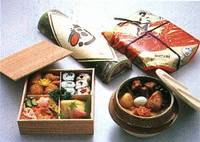
A complete package
TEMPURA
Brought to Japan by the Portuguese, tempura is yet another famous delicacy, best eaten at a tempura bar. It is a deep fried fritter. Prawn or shrimp tempura is the most common but other types are made from squid, pepper, sweet potato, lotus root and onion. Only the freshest fish and vegetables are used. A special sauce ten-tsuyu is used as a dip.
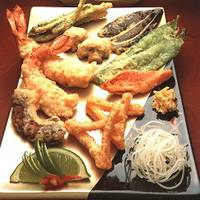
Closest thing to yong tau foo
YAKITORI
Often eaten with sake in a bar is yakitori . This is similar to a shish kebab and is generally made from chicken and grilled on bamboo skewers over charcoal. As the meat is grilled, it is dipped into a sweetened soy-based source to give it a very Japanese flavour.
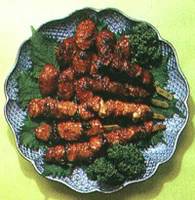
Satay anyone?
SHABU SHABU
A dish which is cooked at the table will create a cosy, friendly atmosphere. Shabu Shabu is a typical example of such a dish and is particularly suitable for a large gathering. At the centre of the table is a large pot of simmering stock. The guests are invited to dip slices of beef and vegetable in the stock to cook them. The cooked food is then dipped into a choice of sauces. When all the meat and vegetables have been cooked, the enriched stock is served as soup. Sukiyaki is very similar to shabu shabu in that it is another dish cooked at the table.
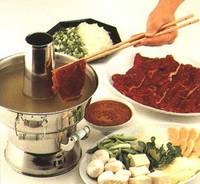
That piece of Kobe beef sure looks enticing!
SAKE
Sake is the national drink of Japan and is made from rice. Unlike most alcoholic beverages, the most enjoyable way to drink sake is when it is warmed up slightly. The drink is served from flasks (tokkuri) and poured from these into tiny cups called sakzuki. The size of the cups allow the drink to be gulped down in one go (which is the way it should be drunk) before it has a chance to cool down. This has it's disadvantages (or advantages !) in that an empty cup usually signifies that you want a re-fill !
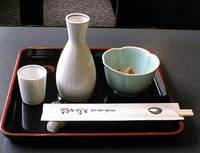
Not intimidating looking but anyone who've ever had sake will testify to its "potency"

Bottoms up my dear!
AND FINALLY...
Whatever the occasion, whether your in a soba-ya or sitting down around a kotatsu on a tatami enjoying a family meal it is traditional to say "Itadakimasu" before starting to eat. This literally means "I shall begin eating" and is equivalent to the French "Bon appetit". After finishing, using the expression "Gochisosama deshita" will signify that the meal "was a feast". Another expression which will go down well with any cook is the expression "Taihen oishikatta desu". It is a phrase which will also sum up Japanese cuisine - "That was very delicious !".
References
1. The Complete Oriental Cook Book - Suzy Powling
2. Far Eastern Cookery - Madhur Jaffrey
3. Coping With Japan - John Randle and Mariko Watanabe
4. Culture Shock Japan - Rex Shelly
5. Japanese Language and People - BBC Publication.
1 comment:
KNN!! Hungry already...
Post a Comment